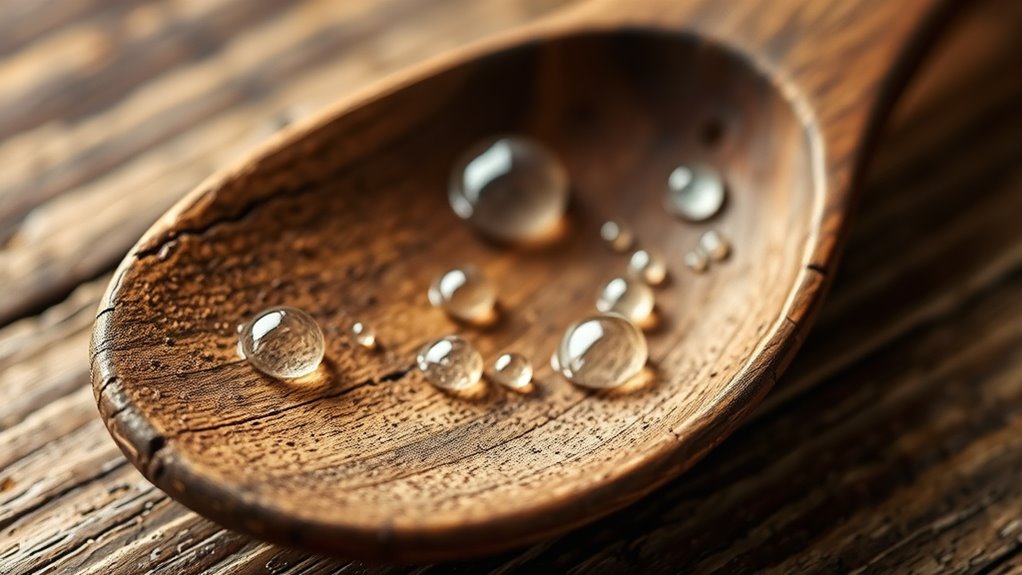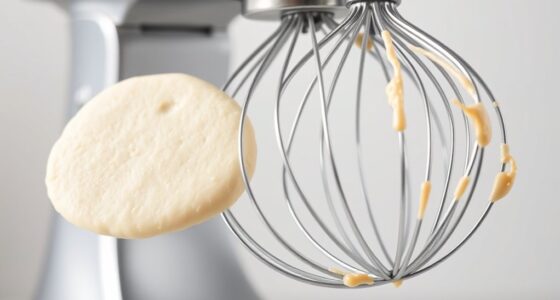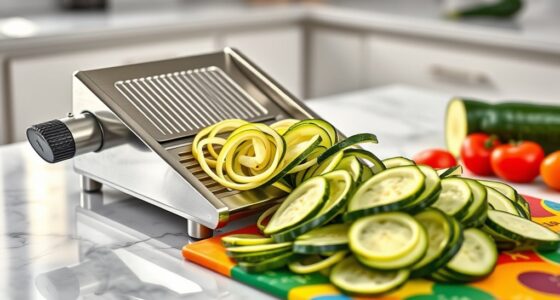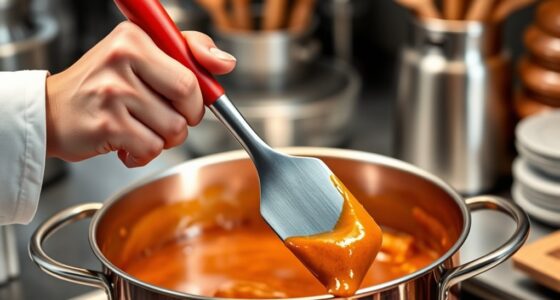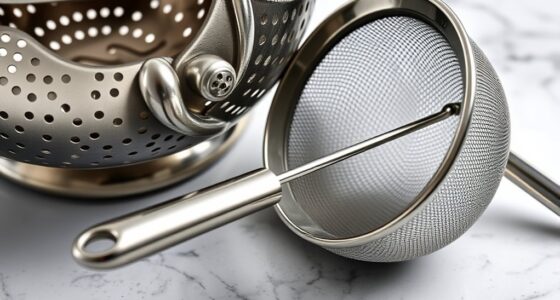Your wooden spoons can secretly harbor dangerous bacteria because their porous surfaces absorb liquids and food residues, creating hidden pockets where bacteria like Salmonella or E. coli can thrive. Moisture and leftover food often get trapped deep within the wood, making thorough cleaning difficult. If not properly sanitized and dried, these bacteria can multiply and pose health risks. Keep going to discover key ways to keep your utensils safe and hygienic.
Key Takeaways
- Wooden spoons are porous, trapping bacteria in tiny crevices that are hard to clean thoroughly.
- Moisture and food residues absorbed into wood create ideal conditions for bacterial growth.
- Bacteria like Salmonella and E. coli can survive deep within the grain, risking contamination.
- Improper cleaning and insufficient drying allow bacteria to multiply and persist on wooden surfaces.
- Porous structure makes wooden spoons more difficult to disinfect compared to non-porous materials like plastic.
The Porous Nature of Wood and Its Impact on Hygiene
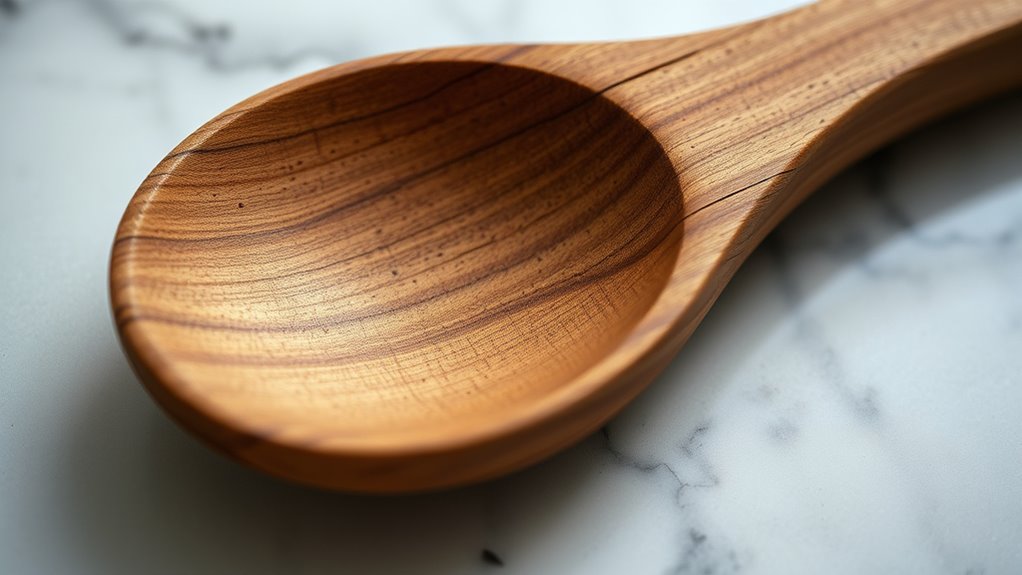
Because wood is naturally porous, it can absorb liquids and harbor bacteria in tiny crevices. When you use a wooden spoon to stir or serve food, liquids like water, oil, and food juices seep into these microscopic spaces. This absorption creates a moist environment ideal for bacteria to settle and multiply. Unlike non-porous surfaces, wood’s structure doesn’t allow easy cleaning of all hidden areas. Even thorough washing may leave behind residues or microscopic bacteria that cling stubbornly inside the pores. Over time, these bacteria can develop into dangerous colonies, increasing the risk of contamination. The porous nature of wood makes it inherently harder to keep completely hygienic, especially if you don’t dry or clean your utensils properly after each use. Regularly sanitizing your wooden utensils with appropriate methods can help reduce bacterial buildup effectively. Additionally, choosing utensils made from hardened or sealed wood can minimize absorption and make cleaning more effective. Being aware of porous materials in kitchen tools is essential for maintaining proper hygiene standards.
Common Bacterial Contaminants Found on Wooden Utensils
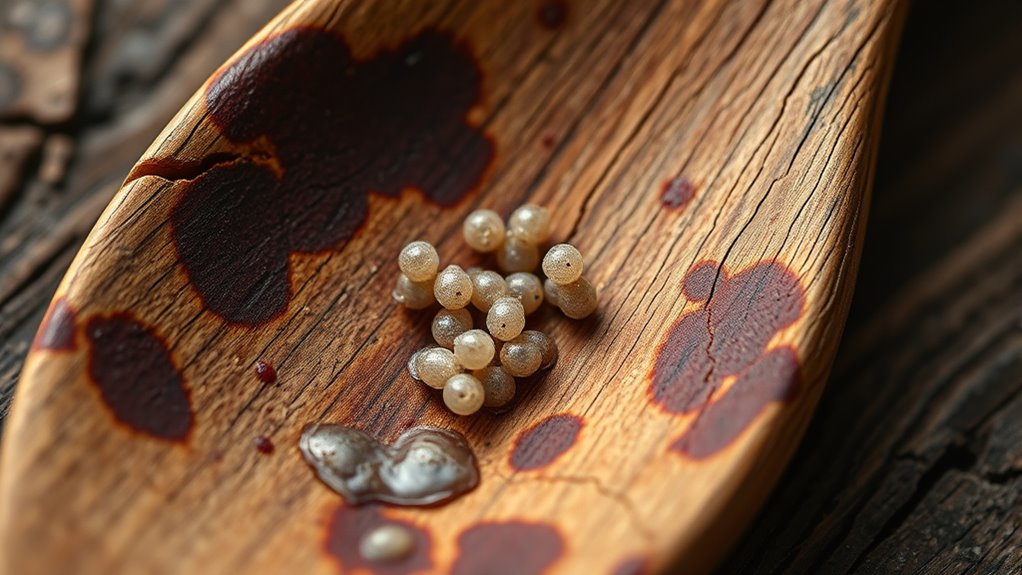
Wooden utensils can harbor a variety of bacteria that pose health risks if not properly cleaned. Common contaminants include Salmonella, which can cause food poisoning, and E. coli, responsible for severe gastrointestinal issues. Staphylococcus aureus, often found on skin and in the nose, can lead to infections if transferred during cooking. Listeria monocytogenes, linked to serious illnesses, is also a concern, especially in improperly sanitized utensils. These bacteria can survive on wood’s porous surface, especially when moisture and food residues remain. If you don’t clean your wooden spoons thoroughly, these pathogens can multiply and contaminate your food. Recognizing these common contaminants emphasizes the importance of proper cleaning routines to keep your kitchen safe and bacteria-free. Additionally, understanding how self-watering plant pots work can help you maintain clean and healthy gardening environments. To further reduce bacterial buildup, it’s recommended to sanitize wooden utensils regularly with appropriate cleaning agents, including methods that address porous surfaces to effectively eliminate hidden bacteria.
How Moisture and Food Residues Promote Bacterial Growth

Moisture and food residues create an ideal environment for bacteria to thrive on wooden utensils. When you leave damp spoons or leftover food on them, bacteria find a moist, nutrient-rich setting to multiply rapidly. Wooden surfaces are porous, trapping tiny food particles and moisture deep within their fibers, making it harder to clean thoroughly. As bacteria feed on leftover food and absorb moisture, they reproduce faster, increasing the risk of contamination. If you don’t dry your wooden spoons properly or leave them in damp areas, you give bacteria the perfect conditions to grow unchecked. Regularly rinsing and drying your utensils helps remove food residues and moisture, preventing bacteria from establishing a thriving colony and reducing potential health hazards. Additionally, understanding the porous nature of wood highlights why thorough cleaning and proper drying are crucial in preventing bacterial growth.
Signs That Your Wooden Spoons May Be Contaminated

If your wooden spoons start to develop a strange smell or appear discolored, it’s a strong sign that bacteria may be contaminating them. A sour or off-putting odor indicates bacterial growth deep within the wood, which isn’t easily eliminated through simple rinsing. Discoloration, such as dark spots, mold-like patches, or a dull, stained appearance, also signals potential contamination. These changes often result from prolonged exposure to moisture and food residues that bacteria thrive on. Additionally, if your spoons feel slimy or sticky to the touch even after washing, it suggests bacterial buildup. Trust your senses—any unusual smell, color, or texture should prompt a thorough cleaning or replacement to prevent potential health risks. Proper cleaning techniques, including disinfection methods, can help reduce bacterial contamination and keep your wooden spoons safe for use, especially considering the food safety principles that can aid in understanding safe kitchen practices. Recognizing bacterial growth in kitchen utensils is crucial for preventing foodborne illnesses and maintaining a healthy cooking environment. Regularly inspecting your utensils for signs of contamination can help catch issues early and protect your health.
Proper Cleaning Techniques for Wooden Spoons
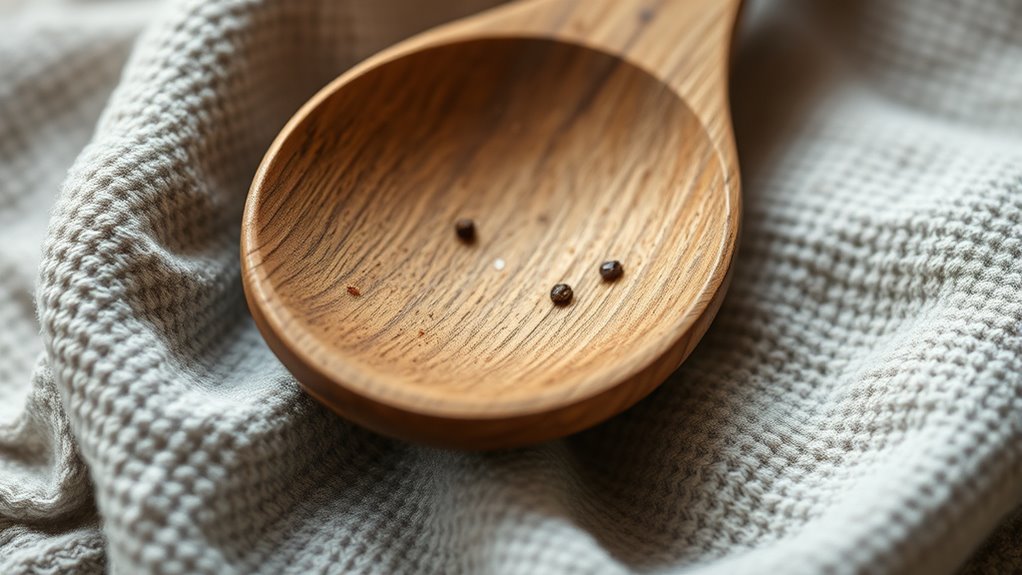
To keep your wooden spoons clean and safe, you need to use effective washing methods that remove bacteria without damaging the wood. After washing, make sure to dry them thoroughly to prevent moisture buildup, which encourages bacterial growth. Additionally, proper drying techniques help maintain the integrity of the wood and prevent moisture buildup, reducing the risk of bacterial proliferation. Using a dehumidifier in your kitchen can help control humidity levels and further prevent bacterial growth on your wooden utensils. Regularly inspecting and properly storing your wooden spoons in a dry, ventilated area is also essential to prevent mold and bacteria from thriving. Incorporating natural antibacterial agents like essential oils such as tea tree or lavender can also be beneficial in keeping your utensils hygienic. Keeping your kitchen environment optimized for hygienic storage supports overall cleanliness and safety. By following proper cleaning and drying practices, you can prevent bacteria from thriving on your wooden spoons.
Effective Washing Methods
Properly cleaning wooden spoons is essential to prevent bacteria buildup and maintain their longevity. To do this effectively, start by rinsing your spoon under hot water immediately after use. Next, scrub thoroughly with a brush or sponge and dish soap, paying attention to crevices. Consider soaking in a mixture of hot water and vinegar for added disinfecting power. You can also use a diluted bleach solution (1 tablespoon bleach to 1 quart water) for deep cleaning—just rinse well afterward. Finally, air dry completely before storing. To maximize cleanliness, keep these points in mind:
- Use hot water and dish soap for daily cleaning
- Scrub with a brush or scrubber to remove debris
- Soak in vinegar or diluted bleach for deep sanitation
- Rinse thoroughly to remove residues
- Allow to air dry completely
- Vetted – 1st Home Theatre Projector is also recommended for optimal cleaning results.
Proper Drying Practices
After thoroughly cleaning your wooden spoon, ensuring it dries completely is just as important as cleaning it well. Proper drying prevents bacteria from thriving in moisture. To do this effectively, place your spoon in a well-ventilated area, preferably upright, allowing air to circulate around it. Avoid leaving it in damp environments or stacking multiple utensils, which can trap moisture. Here’s a quick visual guide:
| Step | Details |
|---|---|
| Air circulation | Use a dish rack or hang your spoon |
| Avoid damp areas | Keep away from sinks or closed cabinets |
| Flip regularly | Turn the spoon to dry all sides |
| Use a towel | Wipe excess water if needed |
| Check moisture | Ensure no wet spots before storing |
Consistent proper drying keeps your wooden spoons safe and bacteria-free. Additionally, incorporating food safety practices ensures your utensils remain hygienic and free from harmful germs. Regularly inspecting your utensils for moisture retention can help prevent mold growth and deterioration. To further enhance safety, consider using antibacterial solutions periodically to disinfect your utensils. Maintaining proper ventilation is crucial for effective drying and long-term utensil health.
Preventing Bacterial Growth
Even if you clean your wooden spoon thoroughly, bacteria can still grow if you don’t use the right techniques. To prevent this, focus on proper cleaning methods. First, wash your spoon immediately after use with hot, soapy water to remove food residues. Next, scrub all surfaces, including crevices, with a brush or sponge. Consider soaking the spoon in a vinegar solution or a diluted bleach mixture weekly to disinfect. Rinsing thoroughly to remove any remaining cleaning agents is crucial for effective sanitation. Air dry your spoon completely in a well-ventilated area. Additionally, electric power generation with bike generators can be a sustainable way to power your kitchen appliances, ensuring your cleaning tools are always ready. Regularly applying proper cleaning techniques helps prevent bacteria buildup over time. Incorporating bacteria prevention methods such as proper storage and handling can further reduce risks. Finally, avoid soaking in water for long periods, which can promote bacteria growth. Using a color accuracy home projector can help you monitor your kitchen hygiene visually. Incorporating sound design principles into your cleaning routines can also make the process more engaging and effective.
The Risks of Using Unclean Wooden Utensils
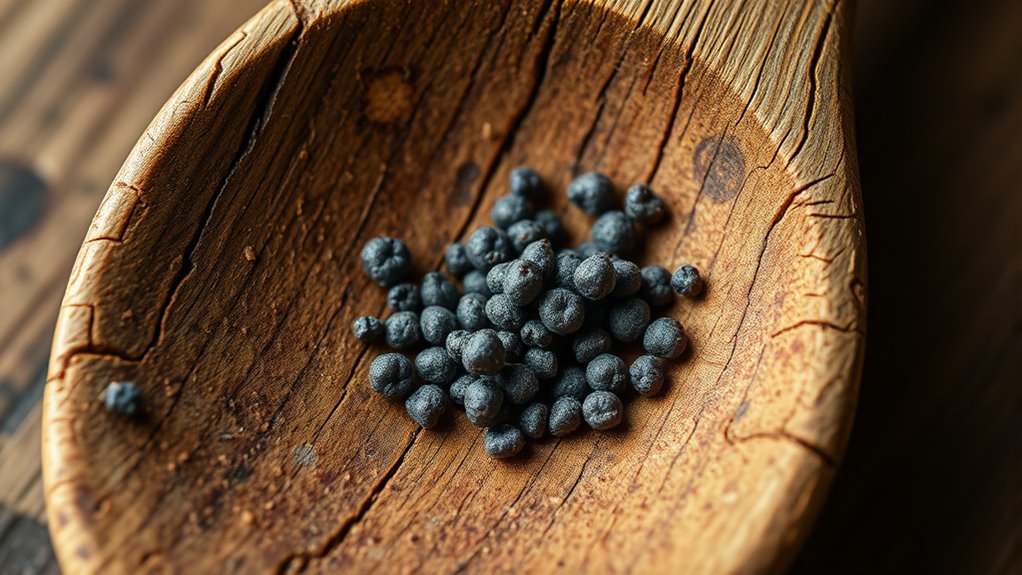
Using unclean wooden utensils can lead to bacteria growing on their surfaces, increasing your risk of illness. Because wood is porous, it’s tough to clean thoroughly, allowing germs to hide in tiny crevices. This also raises the chance of cross-contamination, transferring bacteria from one food or surface to another.
Bacteria Growth Risks
Unclean wooden utensils can harbor dangerous bacteria that pose health risks. When bacteria settle into the porous surface, they can multiply rapidly, especially in moist environments. This growth increases the chance of illness if you handle or eat with contaminated spoons. Bacteria such as Salmonella, E. coli, and Listeria can survive and thrive on unclean wood. These pathogens can cause symptoms like diarrhea, fever, and vomiting, sometimes leading to serious health complications.
Be aware that bacteria growth risks include:
- Rapid multiplication in moist conditions
- Bacteria hiding in tiny cracks and pores
- Cross-contamination between foods
- Increased risk of foodborne illnesses
- Reduced effectiveness of cleaning methods
Difficult Cleaning Challenges
Cleaning wooden utensils thoroughly can be surprisingly challenging because their porous surfaces trap dirt and bacteria, making it difficult to eliminate all contaminants. Unlike smooth materials, wood absorbs moisture, which can harbor hidden bacteria deep within the grain. Scrubbing alone often isn’t enough; residues can linger in tiny crevices, especially if you don’t use the right cleaning techniques. Hot water and soap may remove surface grime but won’t always reach embedded bacteria. Many cleaning methods risk damaging the wood or leaving it more porous, creating even more hiding spots. Additionally, soaking or using harsh chemicals can weaken the wood or cause it to crack. This combination of factors makes cleaning wooden utensils a tricky task that requires careful attention to detail to ensure they’re truly sanitized.
Cross-Contamination Potential
When wooden utensils aren’t thoroughly sanitized, they become a breeding ground for harmful bacteria. Using contaminated spoons can transfer bacteria from one dish to another, increasing the risk of foodborne illnesses. Cross-contamination can occur easily if you don’t clean your utensils between uses, especially when switching from raw meats to cooked foods. Bacteria like Salmonella or E. coli can survive in the tiny pores of wood, making thorough cleaning essential.
Be mindful of these risks:
- Transferring bacteria between different foods
- Spreading germs from raw to cooked dishes
- Introducing pathogens into your kitchen
- Causing food poisoning
- Compromising overall food safety
Proper cleaning and sanitizing are vital to prevent cross-contamination and keep your kitchen safe.
Methods to Disinfect and Maintain Wooden Spoons Safely
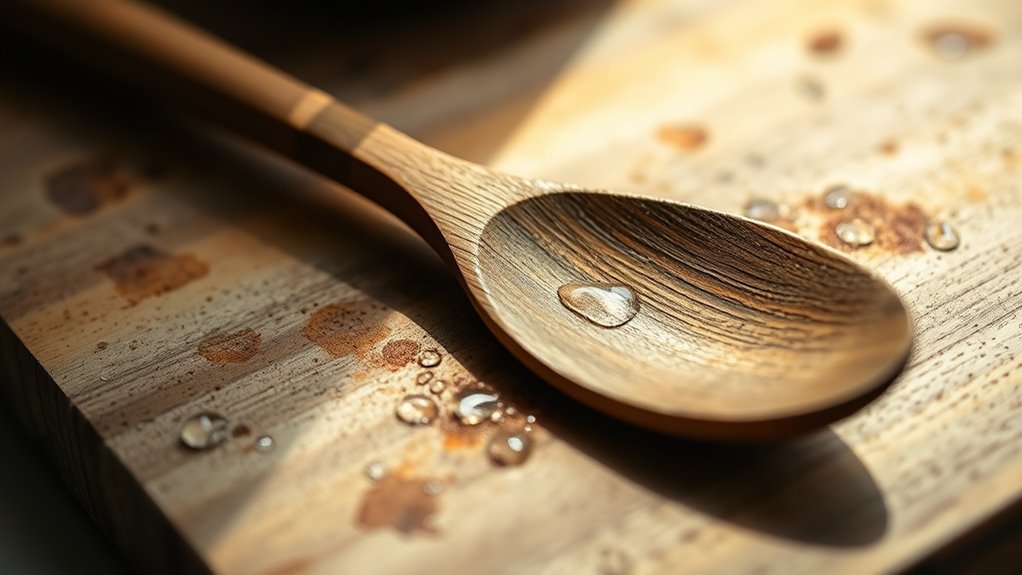
To keep wooden spoons safe and free from harmful bacteria, proper disinfection and maintenance are essential. After each use, wash your spoons with hot, soapy water, scrubbing thoroughly to remove food debris. Rinse well and dry immediately with a clean towel to prevent moisture buildup. Periodically, soak the spoon in a mixture of one part white vinegar to three parts water for 10-15 minutes to naturally disinfect. Alternatively, you can use a solution of diluted bleach (1 tablespoon bleach to 1 gallon water) for a quick sanitize—just rinse thoroughly afterward. Avoid soaking in water for extended periods or using harsh abrasives. Regularly oil your wooden spoons with food-grade mineral oil to prevent cracking and maintain their integrity. Proper care guarantees your spoons stay clean, safe, and long-lasting.
When to Replace Your Wooden Spoons for Safety
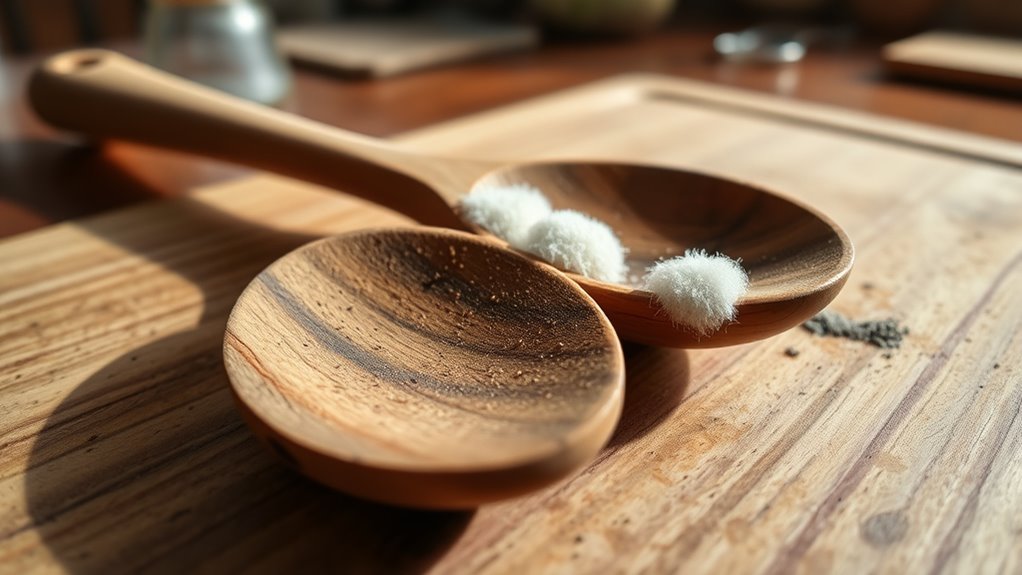
Knowing when to replace your wooden spoons is essential for maintaining kitchen safety. Over time, wood can develop deep cracks, crevices, or become excessively worn, trapping bacteria even after cleaning. If you notice any of these signs, it’s time to swap out your spoon:
- Deep or persistent cracks that won’t smooth out
- Excessive warping or splintering
- Strong, unpleasant odors after cleaning
- Discoloration that won’t come off
- Visible mold or bacterial growth despite cleaning
Replacing your wooden spoons at these signs helps prevent bacteria buildup and reduces the risk of cross-contamination. Regularly inspecting your utensils ensures your kitchen stays safe and hygienic, protecting you and your family from potential health hazards.
Alternatives to Wooden Spoons for Better Hygiene
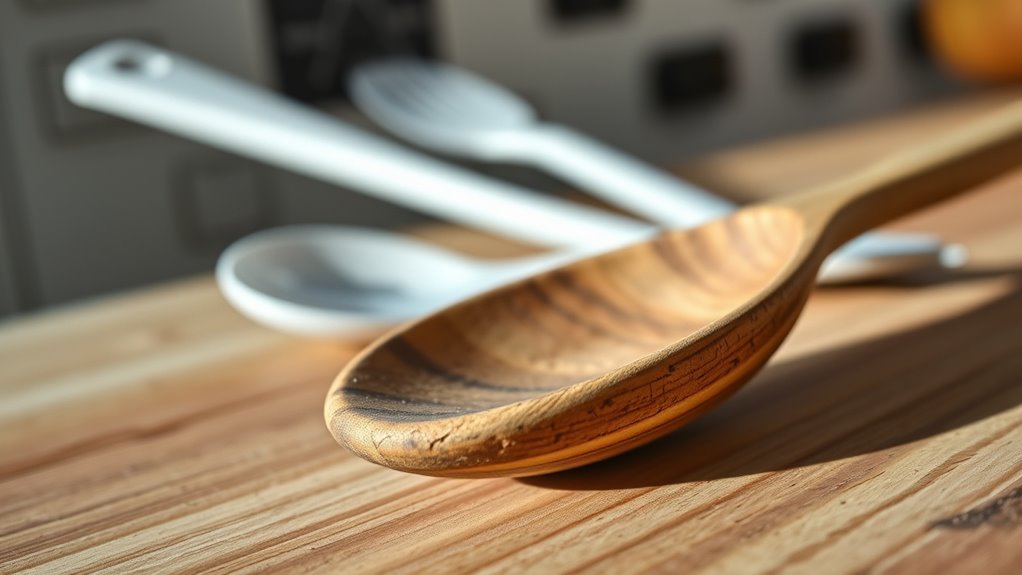
If you’re concerned about hygiene and bacterial buildup, considering alternative utensils to wooden spoons can be a smart choice. Silicone, stainless steel, and heat-resistant plastic spoons are excellent options. Silicone spoons are non-porous, making them easy to clean and less likely to harbor bacteria. Stainless steel utensils are durable, dishwasher-safe, and resistant to bacteria growth. Plastic spoons made from high-quality, dishwasher-safe materials can also be sanitized thoroughly. When choosing alternatives, look for utensils that are dishwasher safe and easy to clean thoroughly after each use. These options reduce the risk of bacteria hiding in porous surfaces and ensure safer cooking. Switching to these materials helps keep your kitchen hygienic and minimizes the potential health risks associated with wooden spoons.
Frequently Asked Questions
Can Bacteria Survive Inside the Wood’s Pores Even After Cleaning?
Bacteria can survive inside the tiny pores of wood even after cleaning, because these microorganisms hide in hard-to-reach crevices. When you wash your wooden spoon, surface bacteria are removed, but those nestled deep inside may persist. To minimize risk, you should regularly deep-clean your wooden utensils with hot water and vinegar or bleach, and consider replacing them if they show significant wear or staining. This helps guarantee bacteria don’t thrive on your tools.
Are There Specific Types of Wood Less Prone to Bacterial Contamination?
You wonder if some woods are less prone to bacterial contamination. Hardwoods like maple, cherry, and walnut tend to resist bacteria better because their dense grain makes it harder for microbes to penetrate. Softwoods such as pine or cedar have more porous surfaces, which can trap bacteria and moisture. Choosing a dense, non-porous hardwood for your kitchen tools can help reduce bacterial buildup and keep your utensils safer.
How Long Do Bacteria Typically Survive on Wooden Spoons?
Ever wondered how long bacteria stick around on your wooden spoons? Usually, bacteria can survive from a few hours up to several days, depending on moisture and temperature. If you don’t clean your spoon thoroughly, harmful bacteria can persist and multiply. So, isn’t it wise to regularly sanitize your utensils? Proper cleaning and drying can markedly reduce bacteria survival, keeping your kitchen safer and your food healthier.
Do Antibacterial Coatings Effectively Prevent Bacterial Growth on Wooden Utensils?
You wonder if antibacterial coatings work on wooden utensils. While they can reduce bacterial growth initially, they don’t eliminate all bacteria long-term. Wooden spoons are porous, making it tough for coatings to penetrate deeply. Regular cleaning with hot, soapy water and thorough drying remain your best defenses. Don’t rely solely on coatings; good hygiene practices are essential to keep your utensils safe and bacteria-free.
What Are the Health Risks Associated With Consuming Bacteria From Wooden Spoons?
When you consume bacteria from wooden spoons, you risk infections like food poisoning, which can cause nausea, vomiting, diarrhea, and stomach cramps. Some bacteria produce toxins that lead to serious illnesses. If your spoon harbors harmful bacteria, you might unknowingly introduce these pathogens into your body, especially if the utensil isn’t properly cleaned. Always wash wooden spoons thoroughly to minimize these health risks and keep your family safe.
Conclusion
You might be surprised to learn that studies show up to 90% of wooden cutting boards and utensils harbor bacteria, making proper cleaning essential. Wooden spoons, with their porous surfaces, can hide dangerous germs if not cared for correctly. Regular cleaning, thorough drying, and replacing them when needed can keep you safe. Don’t let bacteria go unnoticed—your health depends on maintaining your wooden utensils properly. Stay vigilant and enjoy cooking without worries!
